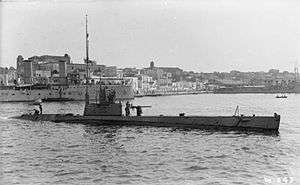HMS H21
HMS H21 was a British H class submarine built by Vickers Limited, Barrow-in-Furness, as the first of the Batch 3 H class submarines. She was laid down on 20 October 1917 and was commissioned on 28 January 1918. H21 was an improved design of the H class which produced a larger displacement and the latest 21 inch torpedo tubes replacing the old 18 inch torpedo tubes. This would be incorporated into all batch 3 H class submarines. HMS H21 was sold to John Cashmore Ltd on 13 July 1926 for scrapping at Newport.
 HMS H4, another submarine of the same class | |
| History | |
|---|---|
| Name: | H21 |
| Builder: | Vickers Limited, Barrow-in-Furness |
| Laid down: | 20 October 1917 |
| Commissioned: | 28 January 1918 |
| Fate: | Sold, 13 July 1926 |
| General characteristics | |
| Class and type: | H class submarine |
| Displacement: |
|
| Length: | 171 ft 0 in (52.12 m) |
| Beam: | 15 ft 4 in (4.67 m) |
| Propulsion: |
|
| Speed: |
|
| Range: |
|
| Complement: | 22 |
| Armament: |
|
Design
Like all post-H20 British H-class submarines, H21 had a displacement of 440 tonnes (430 long tons) at the surface and 500 tonnes (490 long tons) while submerged.[1] It had a total length of 171 feet (52 m),[2] a beam length of 15 feet 4 inches (4.67 m), and a draught length of 12 metres (39 ft).[3] It contained a diesel engines providing a total power of 480 horsepower (360 kW) and two electric motors each providing 320 horsepower (240 kW) power.[3] The use of its electric motors made the submarine travel at 11 knots (20 km/h; 13 mph). It would normally carry 16.4 tonnes (18.1 short tons) of fuel and had a maximum capacity of 18 tonnes (20 short tons).[4]
The submarine had a maximum surface speed of 13 knots (24 km/h; 15 mph) and a submerged speed of 10.5 knots (19.4 km/h; 12.1 mph). Post-H20 British H-class submarines had ranges of 2,985 nautical miles (5,528 km; 3,435 mi) at speeds of 7.5 knots (13.9 km/h; 8.6 mph) when surfaced.[1][3] H21 was fitted with an anti-aircraft gun and four 21 inches (530 mm) torpedo tubes. Its torpedo tubes were fitted to the bows and the submarine was loaded with eight 21 inches (530 mm) torpedoes.[1] It is a Holland 602 type submarine but was designed to meet Royal Navy specifications. Its complement was twenty-two crew members.[1]
References
- "H-class". Battleships-Cruisers, Cranston Fine Arts. Retrieved 20 August 2015.
- Derek Walters (2004). The History of the British 'U' Class Submarine. Casemate Publishers. pp. 2–. ISBN 978-1-84415-131-8.
- Colledge, J. J.; Warlow, Ben (2006) [1969]. Ships of the Royal Navy: The Complete Record of all Fighting Ships of the Royal Navy (Rev. ed.). London: Chatham Publishing. ISBN 978-1-86176-281-8. Retrieved from Naval-History on 20 August 2015.
- J. D. Perkins (1999). "Building History and Technical Details for Canadian CC-Boats and the Original H-CLASS". Electric Boat Company Holland Patent Submarines. Retrieved 20 August 2015.
Bibliography
- Hutchinson, Robert. Submarines, War Beneath The Waves, From 1776 To The Present Day.